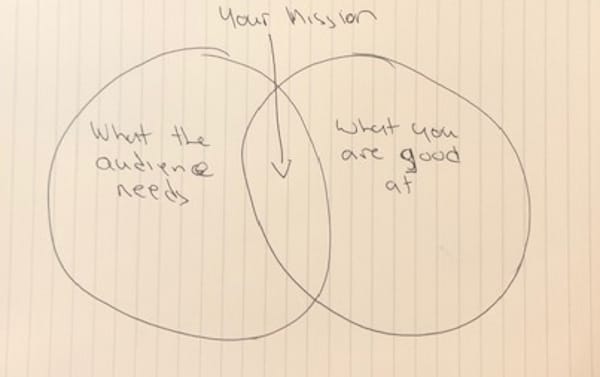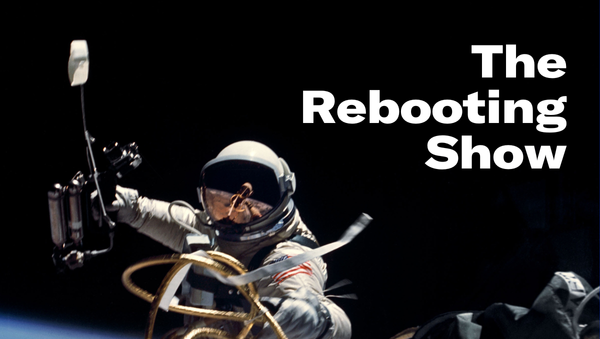Finding your mission
Why figuring out a mission statement is a useful exercise
We are in for a harrowing close to this crisis. The halting distribution of a vaccine certainly feels like the beginning of the end, as we race to get shots in arms before the latest virus variant turns the next wave into a tsunami. To kick off the year, I’m examining the importance of a mission statement, the various newsletter business models and the latest DC insider publication, Punchbowl.
Finding your mission

Mission statements are a lot like most planning: It’s the process that’s most important. Many media companies, especially early on, put off the work around coming up with a mission statement. After all, many mission statements can be cheesy, vague, overblown, or some combination of the three. And what often emerges is an artifact of committee work: too long, trying to do too much.
It was only four or five years in that a group of us at Digiday gathered to come up with a mission. The process was illuminating. It showed that different people viewed the company differently. After all, we had a few somewhat different businesses. For those in editorial, we were animated by the idea of honesty, giving an unvarnished view of how the media business truly works -- and why that resulted in a rigged game for many trying to build businesses the right way. The sales side was about doing more for clients to help them build their businesses. On events, it was about convening. The content studio woke up and went to sleep thinking about how to create content that was both great and drove business.
Our corporate coach made a salient point: We were focused on the how, not the why. What we landed on is the company’s mission was to create change in media. (This was subsequently expanded as Digiday Media expanded into new industries. But the constant was to drive change, the how -- ideally -- was by being honest about the challenges in creating sustainable businesses.) I was reminded of this process listening to Peter Kafka interview Quartz CEO Zach Seward about the publisher’s path forward in organizing around “Make business better.” I like the succinctness and flexibility it provides. Certainly an improvement over “a guide to the new global economy for people in business who are excited by change.”
There can be pushback on mission statements in that they are simplifications. But simple is powerful. Fighting this virus is unimaginably complex, particularly on the communication side. One of the biggest public health failures of this crisis has been poor communication. Compare the messaging in the U.S. and the UK to what Japan adopted early on to get its population on the same side. The government repeatedly stressed avoiding the 3Cs: closed spaces, crowds, close contact.
Identifying a company mission needs the same clarity. I found driving to a common purpose, even in a small company of 70, was a daily challenge, just because people have different goals and even motivations. Turnover is a reality of media and most businesses. Having a tightly defined mission not only helps attract great people by differentiating a company vs its competitors, it also helps them understand the bigger picture that is sometimes lost in the chaos of everyday fires.
Newsletter business models
One 2020 trend that will carry over into 2021: Obsession with Substack. Since podcasts frequently are about podcasting, it stands to reason that every newsletter must veer into discussions about newslettering. One common misconception with Substack Fever is that subscriptions are the only path to making money. That is absolutely not the case.
The power of newsletters is the one-to-one connection, the ability to recreate finishability (pretty sure that’s a made-up word) in digital media, and the opportunity it presents to build a community. Here are the five main business models I see emerging, with publications mixing and matching parts of each, rather than assuming that all roads lead to subscriptions.
All ads. Newsletter ads are effective. They work much better than typical display ads on websites when the newsletter ads are truly native to the experience. That’s why podcasting ads are popular too. You can build a healthy business off ads in newsletter so long as you have enough subscribers of the “right” type. That can be a demographic, passion area, or business sector.
Paid content. This is popular now. Everyone wants to be the Ben Thompson of X. It is also not new. Grant’s Interest Rate Observer costs $1,295 a year for a reason: It is unique and helps people make money. There is a moment when more focus areas are able to convert people into paying $10 or so a month, but this area will continue to be niche and oriented to content that helps already rich people get richer.
Come for the content, stay for the community. Creating great content remains the best way to attract attention and build community. Not every newsletter is a community. But media models where the content is marketing for access to community -- whether that’s events or a dedicated Slack or the ability to comment -- are a powerful hybrid model. Look at The Hustle. The newsletter is a way to draw people into paying for access to the (paid) Trends community with Hustle
Consulting. Unsurprisingly, journalists love writing about journalists striking out on their own and finding riches in newsletters. But look at the top newsletters and you’ll notice they’re written by expert practitioners. Beyond the top tier of stars, there are many practitioners using newsletters as lead gen for pricey consulting gigs.
The resume. Newsletters can be a great way to land a job. They’re a way to showcase how someone thinks in a way that a LinkedIn simply can’t. My former colleague Josh Sternberg is doing this with his Medianut newsletter, which you should check out if you haven’t already.
Too-early thoughts on Punchbowl
Many great quotes are great because they’re not accurate. Take the famous one attributed to Chinese premier Zhou Enlai when asked in 1968 to assess to French Revolution: “Too early to tell.”
I feel similarly often when people assess a publication early. It takes a year or more to find footing as a media brand and figure out your lane. So with that disclaimer, here are some early thoughts on Punchbowl, the new micro-media outfit from Politico alums, including the writers of the Playbook franchise. Some things I like:
- It wants to own the day. As I’ve written before, at Digiday we focused on winning the morning. That led us to publish all our stories at once at midnight. This was a way to both force differentiation and build audience habit. My dream was to create a Digiday AM and Digiday PM. The latter would be a recap of the day’s news for those who aren’t on Twitter all day, bless them. Punchbowl has three editions: morning, midday and evening. This is a smart approach.
- It has a hybrid model. Thank God. As mentioned above, there are a variety of publishing business models. Yes, subscriptions are great -- you can get one to Punchbowl for $300 a year -- but there is a giant lobbying industry in Washington that has to influence the people Punchbowl (and Politico and Axios) reaches. A hybrid model that mixes ads and subs makes all the sense in the world.
- It’s a micro-media company. The solo practitioner model gets a lot of attention and has obvious advantages in sustainability, but my belief is the most enduring publications will be small collectives. 2021 will be the year of “creator burnout.” I still remember career advice given me many years ago by Rishad Tobaccowala: Organizations cover up for our own inefficiencies; we can have bad days. Personal brands also have limited enterprise value.
2021 media trends
Finally, I was asked by Marvin Schade, who writes Medieninsider, for my take on key media trends in 2021. For those who don’t read German, here’s what I came up with:
- The K-shaped recovery. Early hopes for a V-shaped recovery never materialized. Neither did the vaunted U-shaped recovery. Instead, we have seen a K-shaped recovery as the rich do fine, with booming stock markets swelling their wealth as they wait out the pandemic in their vacation homes, while workers are, at best, working 60-hour weeks as Zoom zombies or worse getting sick doing essential jobs that can't be done from the comfort of home. In media, the strong will emerge stronger. Those who entered the crisis with strong balance sheets and strong business models -- think The New York Times, The Financial Times, Business Insider -- will realize outsized gains. The weaker players, preyed on by the strong for talent, will continue to suffer.
- The Trump bump becomes the Trump slump. Soon-to-be-former President Trump was right about one thing: He was very good for the news business. Publishers sold more subscriptions, broadcasters enjoyed higher ratings thanks to the twists and turns, the drama and the farce that was all wrapped up into The Trump Show. That program has been canceled for the 2021 season, leaving the media without a cartoonish villain who reliably delivered fodder for must-read and must-see reporting. The Biden Administration promises a Pivot to Boring, and fights over budget deficits and infrastructure spending don't sell as well.
- Niche media thrives. The pandemic was a great accelerator, pushing forward existing trends by years. It undeniably hastened the end of the scale era of digital media, as monolithic ad-dependent businesses were savaged. In 2021, niche media will take center stage as a rare industry growth area. Whether it's topic-focused Substacks from superstar writers or passion areas like eSports or business-to-business media, niche media is positioned to continue to succeed in 2021.
Thanks for reading. Please get in touch with any thoughts. Also, please share this email with anyone you think would find it valuable.




